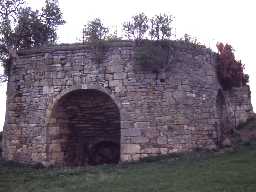Rock Midstead lime kiln (Rennington)
Small field kiln in excellent condition. Three draw arches, round-headed with one eye per arch. (1)
Lime kiln south of Kiln Plantation, 700m south east of Rock Midstead. Probably early 19th century. Nine-sided plan, charging ramp on east. Well-preserved. (2)
Plan, elevations and section through the kiln which has one pot and three arches. Scale 1:100. (3)
A small well-preserved early 19th century estate lime kiln. It stands c.5m high with a nine-sided plan, single pot, three draw arches and charging ramp on the east side. Well-built sandstone masonry structure with mortared limestone bands and firebrick-lined (Radcliffe stamp) circular pot. Internal splayed draw arches, measuring c.3m wide by c.3m high, with dressed sandstone voussoirs, linked by small ventilation tunnels. Draw eyes, of which only the easternmost is visible (other buried beneath soil) have round-headed segmental arches. Rare survival of a contemporary iron safety rail around the edge of the kiln top. Large quarry to the north, is now water-filled and densely planted. Part of a farm trail.
A good example of a typical small Northumberland estate kiln. (4)
Brick and stone structure, infilled and somewhat overgrown. Various conservation/repair interventions evident, including shored arches and iron railings on the top of the surviving wall. (5)
Additional reference. (6a)
Lime kiln south of Kiln Plantation, 700m south east of Rock Midstead. Probably early 19th century. Nine-sided plan, charging ramp on east. Well-preserved. (2)
Plan, elevations and section through the kiln which has one pot and three arches. Scale 1:100. (3)
A small well-preserved early 19th century estate lime kiln. It stands c.5m high with a nine-sided plan, single pot, three draw arches and charging ramp on the east side. Well-built sandstone masonry structure with mortared limestone bands and firebrick-lined (Radcliffe stamp) circular pot. Internal splayed draw arches, measuring c.3m wide by c.3m high, with dressed sandstone voussoirs, linked by small ventilation tunnels. Draw eyes, of which only the easternmost is visible (other buried beneath soil) have round-headed segmental arches. Rare survival of a contemporary iron safety rail around the edge of the kiln top. Large quarry to the north, is now water-filled and densely planted. Part of a farm trail.
A good example of a typical small Northumberland estate kiln. (4)
Brick and stone structure, infilled and somewhat overgrown. Various conservation/repair interventions evident, including shored arches and iron railings on the top of the surviving wall. (5)
Additional reference. (6a)
N5057
ENVIRONMENTAL IMPACT ASSESSMENT, A1 in Northumberland 2017; Jacobs
Disclaimer -
Please note that this information has been compiled from a number of different sources. Durham County Council and Northumberland County Council can accept no responsibility for any inaccuracy contained therein. If you wish to use/copy any of the images, please ensure that you read the Copyright information provided.
